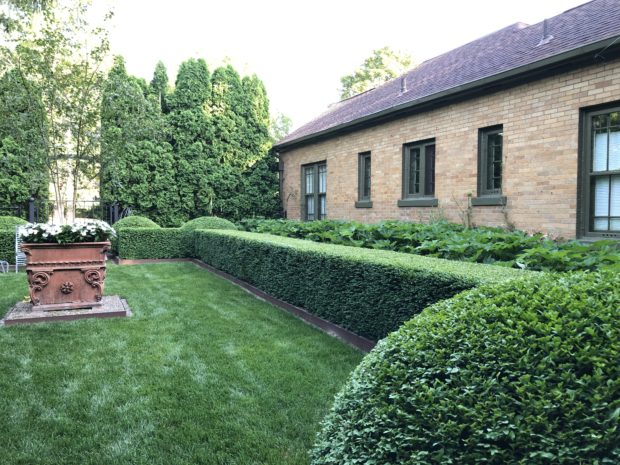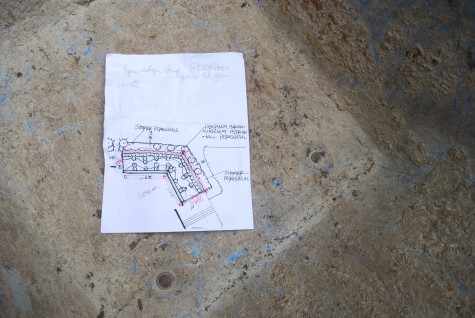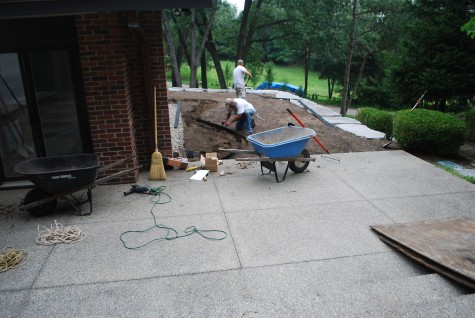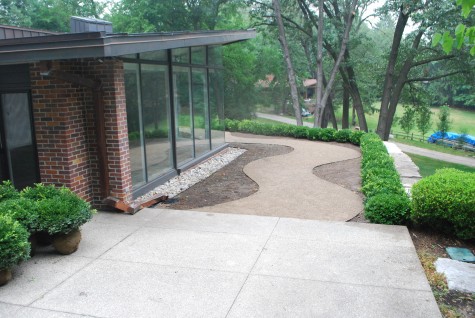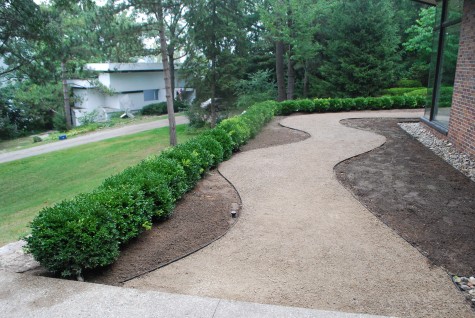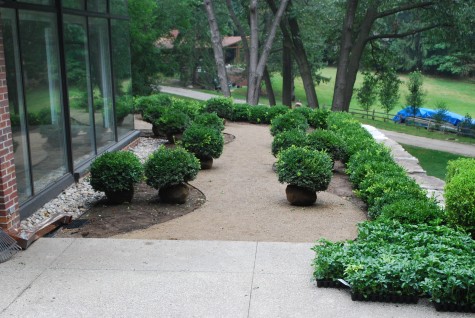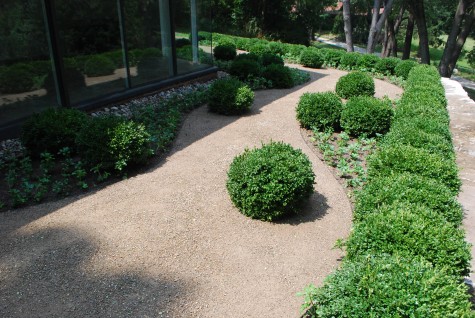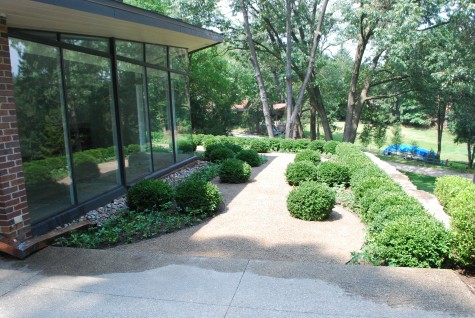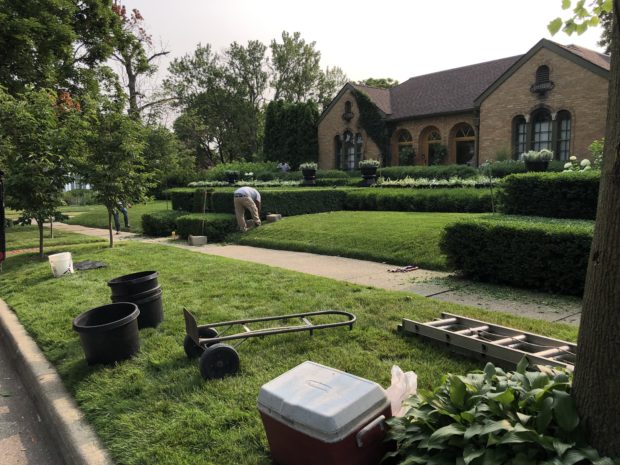 The day that Melissa and her crew comes to prune my boxwood is my favorite day of the gardening year. First and foremost, their pruning is extraordinarily true and square. So precise. It takes a while to set up all of the level lines that will serve at a cutting guide. But beyond the string lines is a skill that is astonishing to watch. The coordination between the eye, and a heavy pair of shears held either horizontally or vertically takes strength, patience, experience, and talent. Loads of talent. I so admire their skill, concentration and resolve. Pruning my boxwood takes the better part of a day.
The day that Melissa and her crew comes to prune my boxwood is my favorite day of the gardening year. First and foremost, their pruning is extraordinarily true and square. So precise. It takes a while to set up all of the level lines that will serve at a cutting guide. But beyond the string lines is a skill that is astonishing to watch. The coordination between the eye, and a heavy pair of shears held either horizontally or vertically takes strength, patience, experience, and talent. Loads of talent. I so admire their skill, concentration and resolve. Pruning my boxwood takes the better part of a day.
 Secondly, that pruning is a natural extension of the intent of the design. The pleasure I derive from my primarily evergreen landscape is a simple one. I like what weather does to the landscape. Weather acting on the landscape changes the look and experience of it, day after day. The sunny days create shadows that highlight the forms. Overcast days emphasize the contrast of the leaf texture with the volume and mass of the shapes. The random leaves falling from the trees in October provide as much fresh interest as a dusting of new snow. Rain makes all of the evergreen surfaces sparkle.
Secondly, that pruning is a natural extension of the intent of the design. The pleasure I derive from my primarily evergreen landscape is a simple one. I like what weather does to the landscape. Weather acting on the landscape changes the look and experience of it, day after day. The sunny days create shadows that highlight the forms. Overcast days emphasize the contrast of the leaf texture with the volume and mass of the shapes. The random leaves falling from the trees in October provide as much fresh interest as a dusting of new snow. Rain makes all of the evergreen surfaces sparkle.
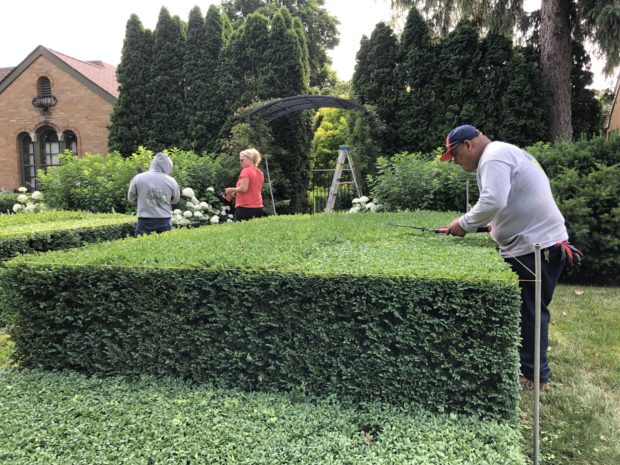 The boxwood is the most formal element of the landscape, as both the placement and pruning is formal. That hand pruning makes all of the forms clear. That snip snip snip goes on all day long. The sound is regular, and musical. The painstakingly trimmed boxwood is a beautiful contrast to the big wild growing hydrangeas. Boxwood left to its own devices has a beautiful and gently shaggy appearance. That look can work well in a variety of circumstances. But I favor a look that is orderly and defined. I find that clean crisp look relaxing. It is the feeling I want, when I am in the garden.
The boxwood is the most formal element of the landscape, as both the placement and pruning is formal. That hand pruning makes all of the forms clear. That snip snip snip goes on all day long. The sound is regular, and musical. The painstakingly trimmed boxwood is a beautiful contrast to the big wild growing hydrangeas. Boxwood left to its own devices has a beautiful and gently shaggy appearance. That look can work well in a variety of circumstances. But I favor a look that is orderly and defined. I find that clean crisp look relaxing. It is the feeling I want, when I am in the garden.
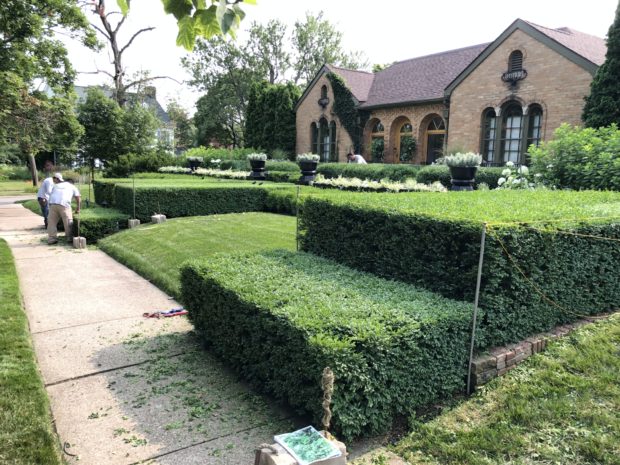 Melissa and her crew take what I have taken great pains to grow, and prune them into distinct shapes. It is amazing how much they grow out in a year’s time. The pruning timing can be tricky. I do not like to prune before the spring flush is finished. Pruning too early means it will take another round later on to keep them neat. So later in June, in my zone. I also like to prune before the weather gets too hot. Pruning on a 90 degree day will insure that the tender growth underneath that has been completely shaded will burn in the blazing hot sun. Pruning is a call to grow, so I try not to prune later in the season. Evergreen plants should begin the shutting down process in August, so when the winter comes, they are completely dormant.
Melissa and her crew take what I have taken great pains to grow, and prune them into distinct shapes. It is amazing how much they grow out in a year’s time. The pruning timing can be tricky. I do not like to prune before the spring flush is finished. Pruning too early means it will take another round later on to keep them neat. So later in June, in my zone. I also like to prune before the weather gets too hot. Pruning on a 90 degree day will insure that the tender growth underneath that has been completely shaded will burn in the blazing hot sun. Pruning is a call to grow, so I try not to prune later in the season. Evergreen plants should begin the shutting down process in August, so when the winter comes, they are completely dormant.
 Most of these boxwood are better than 20 years old. Clearly they cheerfully tolerate this type of pruning. Not all evergreens like this. Yews especially can die out on the interior if they are pruned into densely formal shapes. They need some air and light to penetrate to the interior. All of the spreading yews on my property have a natural look to them, for exactly that reason. A healthy plant is a beautiful plant. If I am looking for a hedging yew with a formal shape, I choose a cultivar that grows that way, naturally. Taxus media “Mooni” is a formal grower, and rarely needs much pruning to keep it in shape.
Most of these boxwood are better than 20 years old. Clearly they cheerfully tolerate this type of pruning. Not all evergreens like this. Yews especially can die out on the interior if they are pruned into densely formal shapes. They need some air and light to penetrate to the interior. All of the spreading yews on my property have a natural look to them, for exactly that reason. A healthy plant is a beautiful plant. If I am looking for a hedging yew with a formal shape, I choose a cultivar that grows that way, naturally. Taxus media “Mooni” is a formal grower, and rarely needs much pruning to keep it in shape.
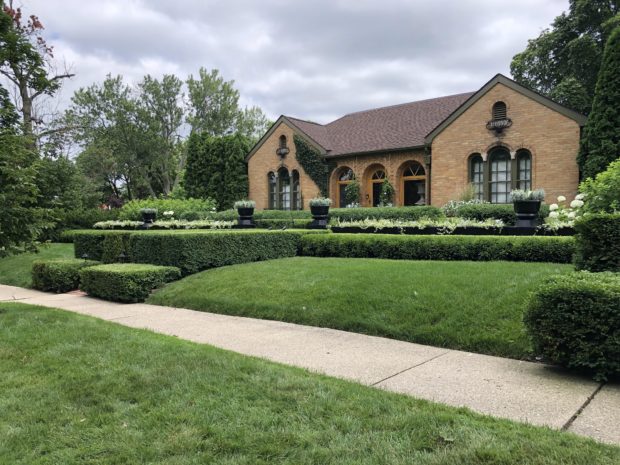 At days end, I still like the composition decades old. And I know that, as Henry Mitchell once wrote, great gardens are the result of the intensive care of the present. The care my landscape gets might easily be more important than the design. Well cared for is always a good look. Mow the grass, pull the weeds, and prune the shrubs.
At days end, I still like the composition decades old. And I know that, as Henry Mitchell once wrote, great gardens are the result of the intensive care of the present. The care my landscape gets might easily be more important than the design. Well cared for is always a good look. Mow the grass, pull the weeds, and prune the shrubs.
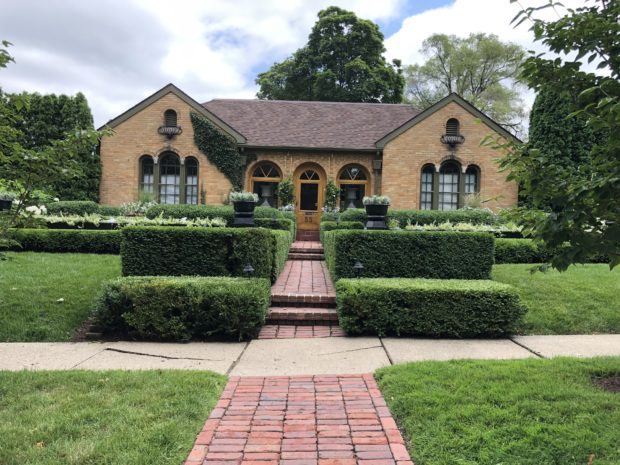 I drive Milo and I here every day after work. For several years now, I have parked in front, and ushered my dogs up the front steps. Howard needed help going up even a single step. This was the easiest way in for him. I could lift him over the two sets of two steps. He passed away in late May, but Milo and I still enjoy coming home, and walking up to the front door. How this looks after the trim makes me happy to come home.
I drive Milo and I here every day after work. For several years now, I have parked in front, and ushered my dogs up the front steps. Howard needed help going up even a single step. This was the easiest way in for him. I could lift him over the two sets of two steps. He passed away in late May, but Milo and I still enjoy coming home, and walking up to the front door. How this looks after the trim makes me happy to come home.
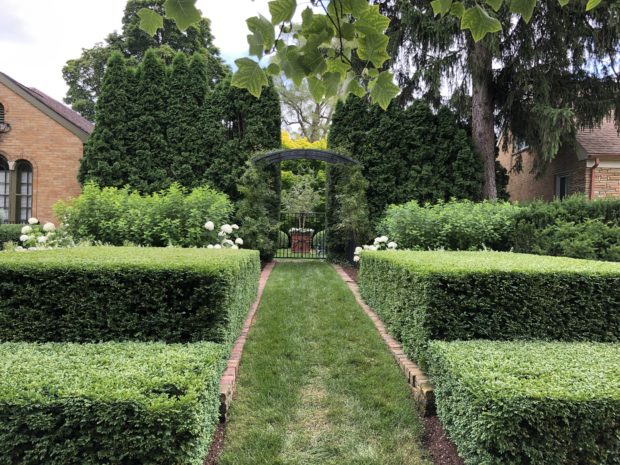 I do have a secondary entrance to the side garden. Trimmed boxwood hugs the grass ramp up. The design here makes much of the foreground boxwood, the midground hydrangeas, and the far ground container in the side yard. In the background is a glimpse of the Princeton Gold maple trees. This is a good summer look, but it looks good no matter the season. And no matter the weather.
I do have a secondary entrance to the side garden. Trimmed boxwood hugs the grass ramp up. The design here makes much of the foreground boxwood, the midground hydrangeas, and the far ground container in the side yard. In the background is a glimpse of the Princeton Gold maple trees. This is a good summer look, but it looks good no matter the season. And no matter the weather.
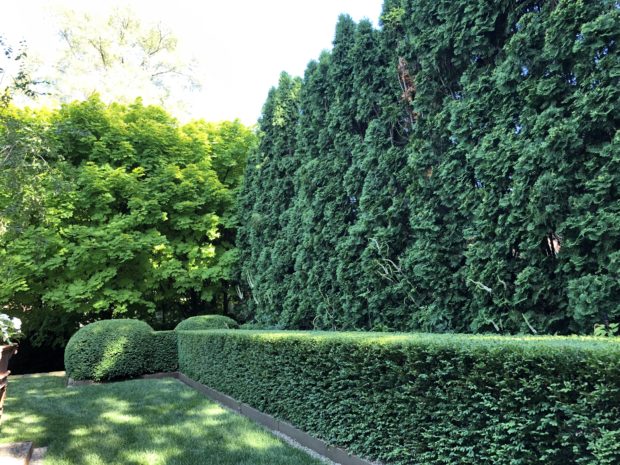 The side yard boxwood is accompanied by an old hedge of thuja nigra, and a stand of Princeton Gold maple trees to the east on the lower level. I like all of the green. From the trees down to the grass. Peaceful, this.
The side yard boxwood is accompanied by an old hedge of thuja nigra, and a stand of Princeton Gold maple trees to the east on the lower level. I like all of the green. From the trees down to the grass. Peaceful, this.
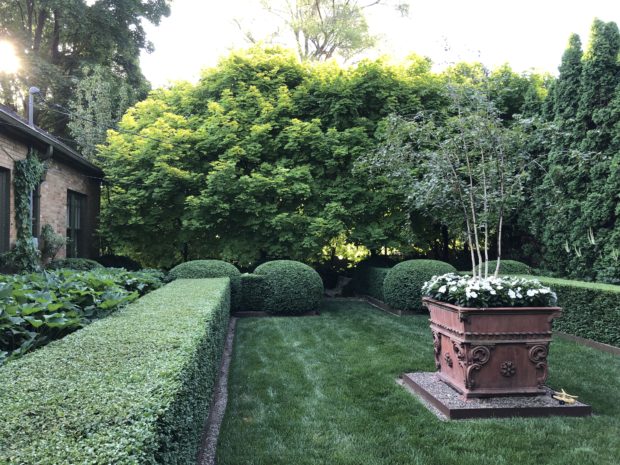 These side yard boxwoods are at least 20 years old. All trimmed up, they do my head, heart and eye a world of good. The edger strip enclosing the gravel at their base has been in long enough to go wobbly. But the boxwood is as level straight and true as can be.
These side yard boxwoods are at least 20 years old. All trimmed up, they do my head, heart and eye a world of good. The edger strip enclosing the gravel at their base has been in long enough to go wobbly. But the boxwood is as level straight and true as can be.
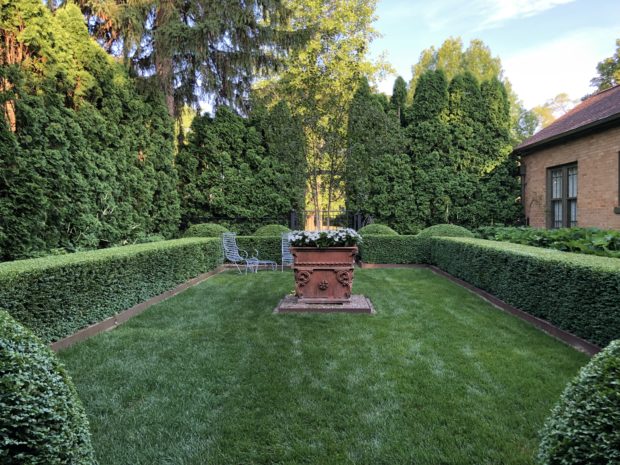 Buck, Milo and I come up here every night to talk over the news of the day. This years news? The boxwood has grown out enough to be flush with the raised steel edger strip. It has taken many years to get to this point, but I am loving the look. The big idea? Those simple pleasures in a landscape can mean so much. Simple is good for the three of us. Well maintained makes every garden maker feel better.
Buck, Milo and I come up here every night to talk over the news of the day. This years news? The boxwood has grown out enough to be flush with the raised steel edger strip. It has taken many years to get to this point, but I am loving the look. The big idea? Those simple pleasures in a landscape can mean so much. Simple is good for the three of us. Well maintained makes every garden maker feel better.
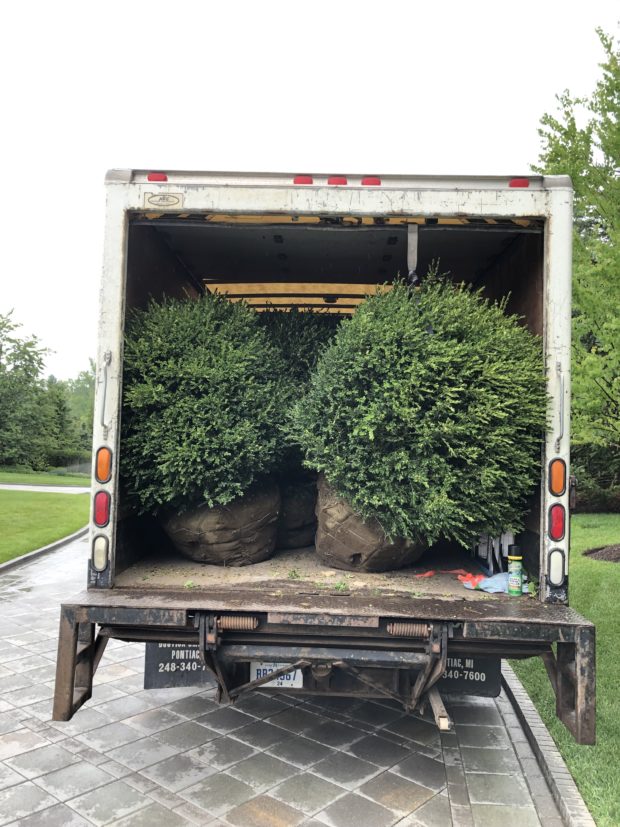 As a designer, I take a good bit of time trying to find out what clients want from their landscapes. That is key to providing them a good design. This client has some big boxwood in her future.
As a designer, I take a good bit of time trying to find out what clients want from their landscapes. That is key to providing them a good design. This client has some big boxwood in her future.
